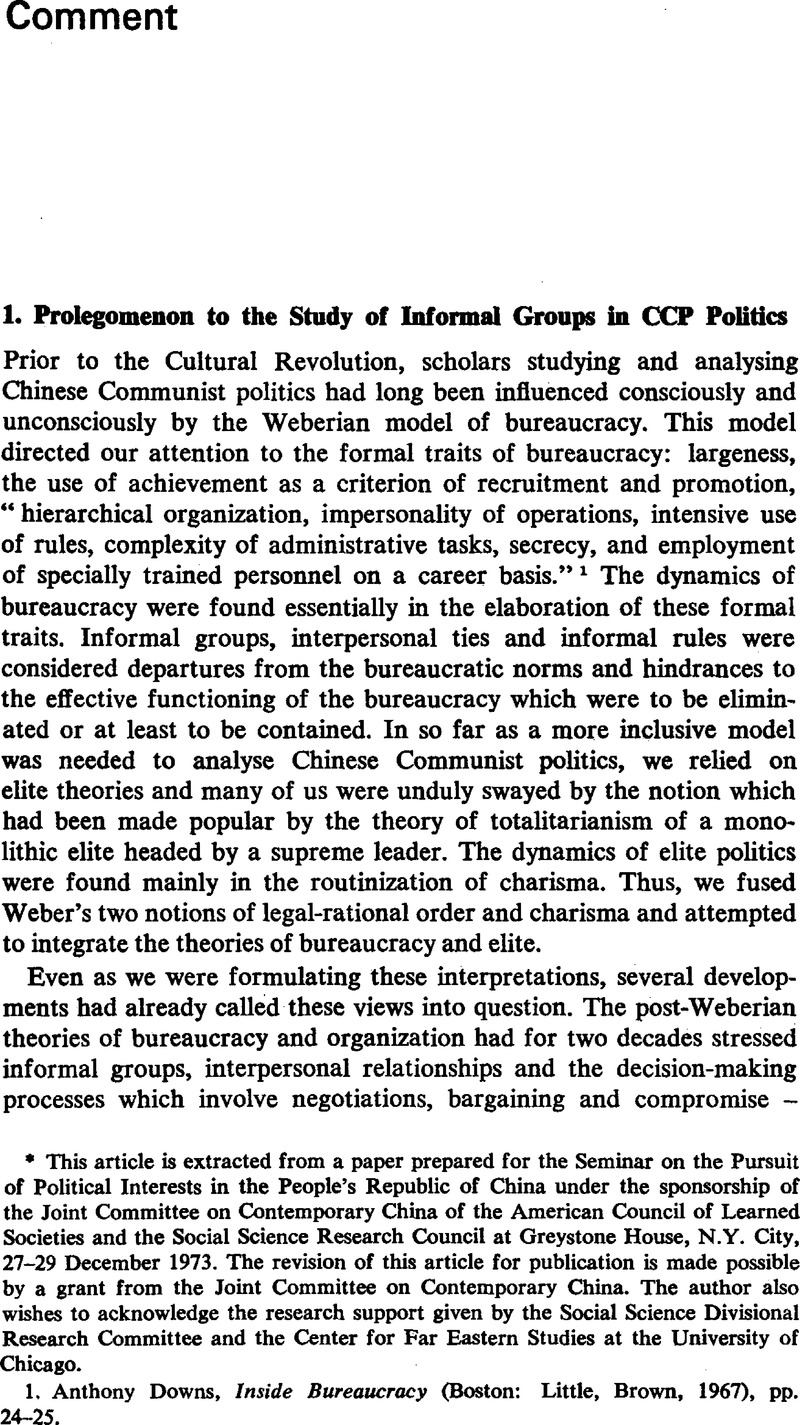Published online by Cambridge University Press: 17 February 2009

1. Downs, Anthony, Inside Bureaucracy (Boston: Little, Brown, 1967), pp. 24–25.Google Scholar
2. Nathan, Andrew, “A factionalism model for CCP politics,” The China Quarterly, No. 53 (1973), p. 44. The results of Nathan’s intellectual effort cannot be called a model in the strict sense of the term, but I shall follow his usage for reasons of style.Google Scholar
3. The term “ quasi-horizontal ties “ includes those linking the formal head of a bureaucratic unit (e.g. the first secretary of a Party Committee) with his lieutenants (e.g. the other secretaries and members of that Party Committee). The ties between P’eng Chen and his lieutenants were hierarchical in terms of his position as a member of the Politburo and a ranking member of the Secretariat. In his capacity as the first secretary of the Peking Party Committee, his ties with his lieutenants were quasi-horizontal.
4. F. G. Bailey denned “ faction “ as a group of persons without a common ideology as a basis for co-operation and recruited by a leader with whom they have a transactional relationship. This definition is not adopted in this paper and what is called “ informal group “ is different from Bailey’s “ faction “ in the sense that it can also derive its strength and solidarity from shared ideology, common goals and agreement on policy. But Bailey’s analysis of the processes of the evolution of a “ faction “ into a formal structure is applicable to our “ informal group.” Bailey, F. G., Stratagems and Spoils (Oxford: Basil Blackwell, 1969), pp. 51–57.Google Scholar
5. Wu, Silus, Communication and Imperial Control in China (Cambridge, Mass.: Harvard University Press, 1970).CrossRefGoogle Scholar
6. Nathan, “A factionalism model,” p. 66.
7. Ibid. p. 46.
8. Ibid.
9. Ibid. p. 58.
10. Harrison, James P., The Long March to Power: A History of the Chinese Communist Party, 1921–72 (New York: Praeger, 1972), p. 173.Google Scholar
11. Kim, Ilpyong J., The Politics of Chinese Communism (Berkeley: University of California Press, 1973), Chaps. III and IV.Google Scholar
12. ”Resolution on questions in Party history,” Selected Works of Mao Tse-tung, Vol. III (Peking: Foreign Languages Press, 1965), pp. 185–93 and 208–10.Google Scholar
13. Nathan, “A factionalism model,” p. 62.
14. See MacFarquhar, Roderick, The Origins of the Cultural Revolution (N.Y.: Columbia University Press, 1974), Vol. I.Google Scholar
15. Nathan, “ A factionalism model,” pp. 49 and 51.
16. Ibid. pp. 55 note and 65.
17. Stalin’s use of the secret police to control the Party is a prime example of the use of a separate monitoring agency as a device to control a large bureau cracy. For a discussion of monitoring organizations, see Downs, Inside Bureau cracy, pp. 144–53.
18. The primacy of one bureaucracy over other bureaucracies can be analy tically distinguished from a pattern of control in which one bureaucracy is used merely as an agency to monitor other bureaucracies. In the former pattern, the functions of the premier bureaucracy are comprehensive and diffuse while in the latter pattern the function of the monitoring agencies is narrow and specific. The differences between the two patterns can also be examined in terms of the relationships of the recruitment and promotion systems in the different bureau cracies as well as the frequency and ease of the assumption by a single individual of multiple roles in different bureaucracies and of the exchange of roles from one bureaucracy to another.
19. A vivid description of the use of some of these formal powers can be found in “ Summary of Chairman Mao’s conversations with responsible comrades in various localities during the period of the inspection tour of the provinces (from Mid-August to September 12, 1971),” Chung Kung yen-chiu (Studies on Chinese Communism), September 1972, pp. 81–96.
20. Dore, Donald Philip, “Function and cause” in Demerath, N. J. III and Peterson, Richard A. (eds.), System, Change, and Conflict (N.Y.: Free Press, 1967), pp. 403–19.Google Scholar